1998 CHEVROLET CAVALIER tow
[x] Cancel search: towPage 21 of 400
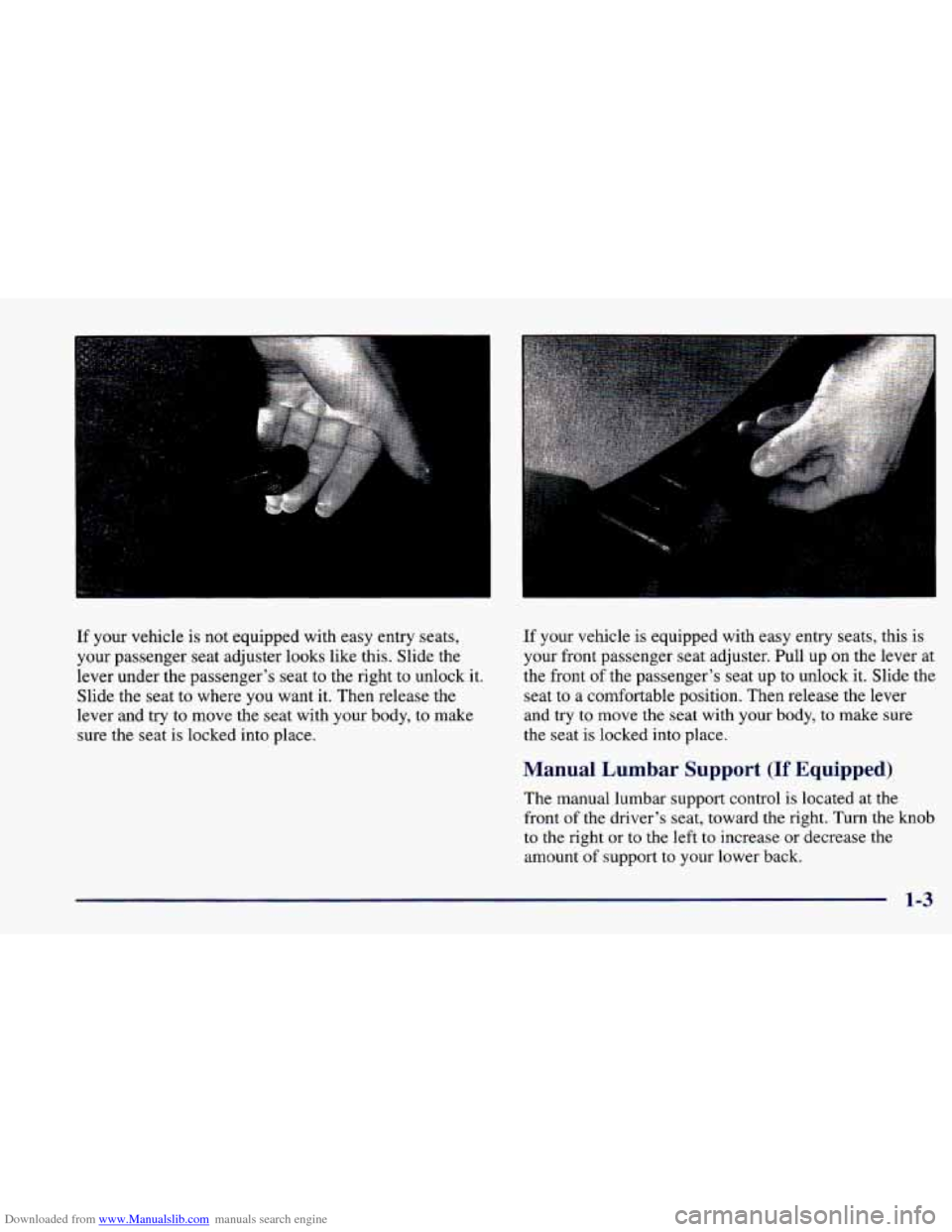
Downloaded from www.Manualslib.com manuals search engine 1
If your vehicle is not equipped with easy entry seats,
your passenger seat adjuster looks like this. Slide the
lever under the passenger's seat to the right to unlock it.
Slide the seat to where you want
it. Then release the
lever and try to move the seat with your body, to make
sure the seat is locked into place.
If your vehicle is equipped with easy entry seats, this is
your front passenger seat adjuster. Pull up on the lever at
the front
of the passenger's seat up to unlock it. Slide the
seat to a comfortable position. Then release the lever
and try to move the seat with your body, to make sure
the seat is locked into place.
Manual Lumbar Support (If Equipped)
The manual lumbar support control is located at the
front of the driver's seat, toward the right. Turn the knob
to the right or to the left to increase or decrease the
amount
of support to your lower back.
1-3
Page 45 of 400
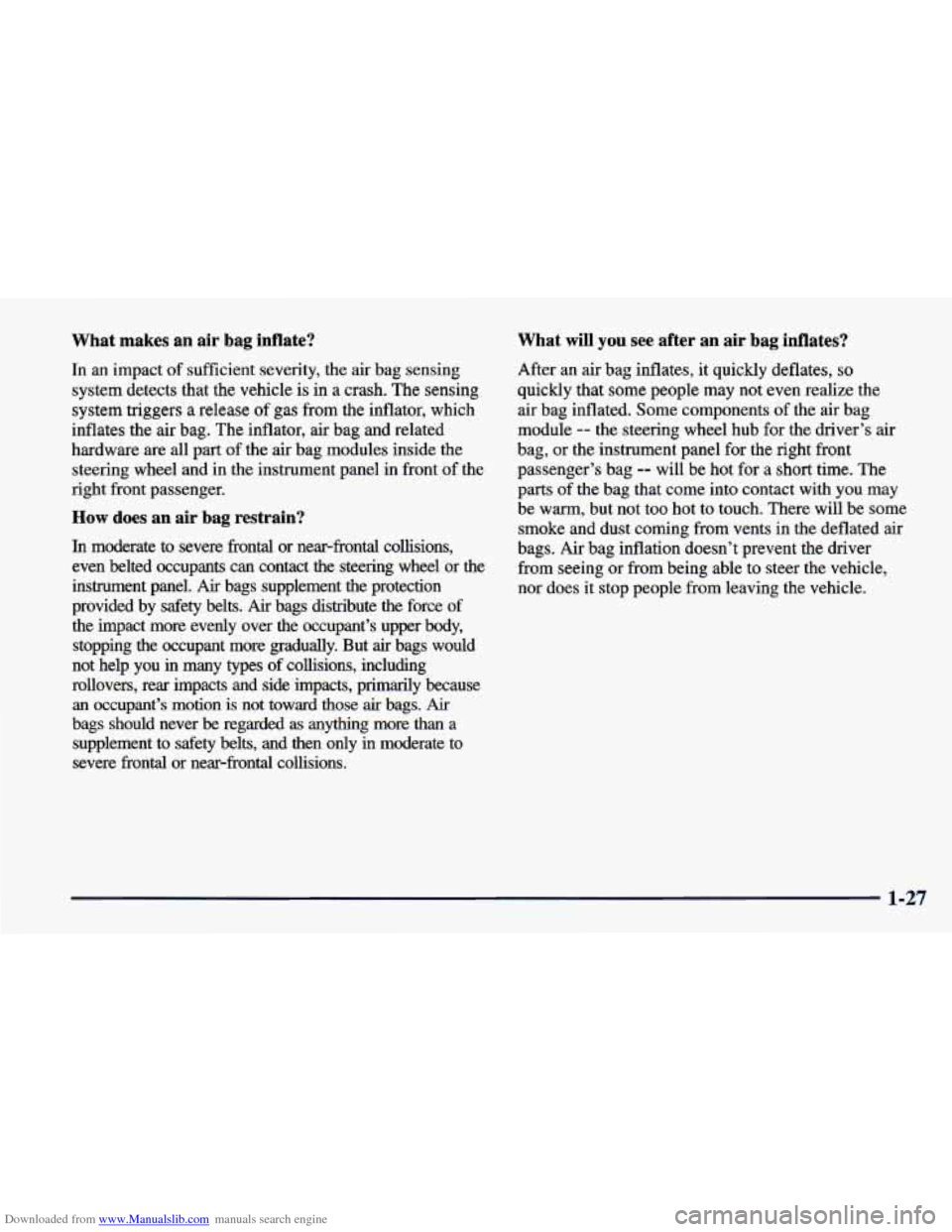
Downloaded from www.Manualslib.com manuals search engine What makes an air bag inflate?
In an impact of sufficient seventy, the air bag sensing
system detects that the vehicle
is in a crash. The sensing
system triggers a release
of gas from the inflator, which
inflates the air bag. The inflator, air bag and related
hardware are all part
of the air bag modules inside the
steering wheel and in the instrument panel in front of the
right front passenger.
How does an air bag restrain?
In moderate to severe frontal or near-frontal collisions,
even belted occupants can contact the steering wheel or the
instrument panel.
Air bags supplement the protection
provided by safety
belts. Air bags distribute the force of
the impact more evenly over the occupant’s upper body, stopping the occupant more gradually. But
air bags would
not help you in many types of collisions, including
rollovers, rear impacts and side impacts, primarily because an occupant’s motion
is not toward those air bags. Air
bags should never be regarded as anythng more than a
supplement to
safety belts, and then only in moderate to
severe frontal or near-frontal collisions.
What will you see after an air bag inflates?
After an air bag inflates, it quickly deflates, so
quickly that some people may not even realize the
air bag inflated. Some components of the air bag
module
-- the steering wheel hub for the driver’s air
bag, or the instrument panel
for the right front
passenger’s bag
-- will be hot for a short time. The
parts
of the bag that come into contact with you may
be warm, but not
too hot to touch. There will be some
smoke and dust coming from vents in the deflated air
bags. Air bag inflation doesn’t prevent the driver
from seeing or from being able to steer the vehicle,
nor does it stop people from leaving the vehicle.
1-27
Page 47 of 400
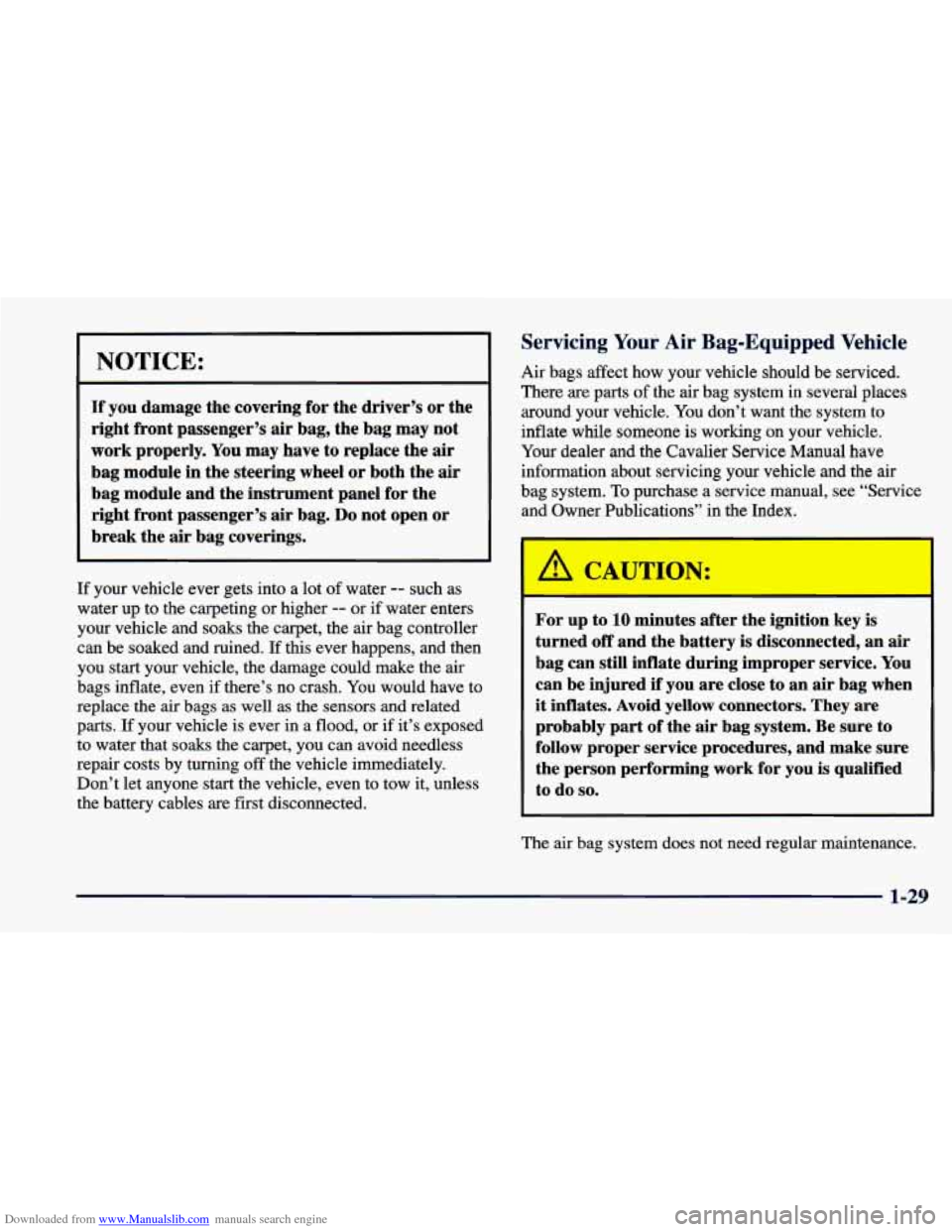
Downloaded from www.Manualslib.com manuals search engine NOTICE:
If you damage the covering for the driver’s or the
right front passenger’s air bag, the bag may not
work properly. You
may have to replace the air
bag module in the steering wheel
or both the air
bag module and the instrument panel for the
right front passenger’s air bag.
Do not open or
break the
air bag coverings.
Servicing Your Air Bag-Equipped Vehicle
Air bags affect how your vehicle should be serviced.
There are parts
of the air bag system in several places
around your vehicle. You don’t want the system to
inflate while someone is working on your vehicle.
Your dealer and the Cavalier Service Manual have
information about servicing your vehicle and the
air
bag system. To purchase a service manual, see “Service
and Owner Publications”
in the Index.
I
If your vehicle ever gets into a lot of water -- such as
water
up to the carpeting or higher -- or if water enters
your vehicle and soaks the carpet, the
air bag controller
can be soaked and ruined.
If this ever happens, and then
you start your vehicle, the damage could make the
air
bags inflate, even if there’s no crash. You would have to
replace the air bags
as well as the sensors and related
parts. If your vehicle is ever in a flood, or if it’s exposed
to water that
soaks the carpet, you can avoid needless
repair costs by turning
off the vehicle immediately.
Don’t let anyone start the vehicle, even to tow it, unless \
the battery cables are first disconnected.
For up to 10 minutes after the ignition key is
turned
off and the battery is disconnected, an air
bag can still inflate during improper service. You
can be injured if you are close to an air bag when
it inflates. Avoid yellow connectors. They are
probably part of the air bag system. Be sure to
follow proper service procedures, and make sure
the person performing work for you is qualified
to do
so.
The air bag system does not need regular maintenance.
1-29
Page 58 of 400
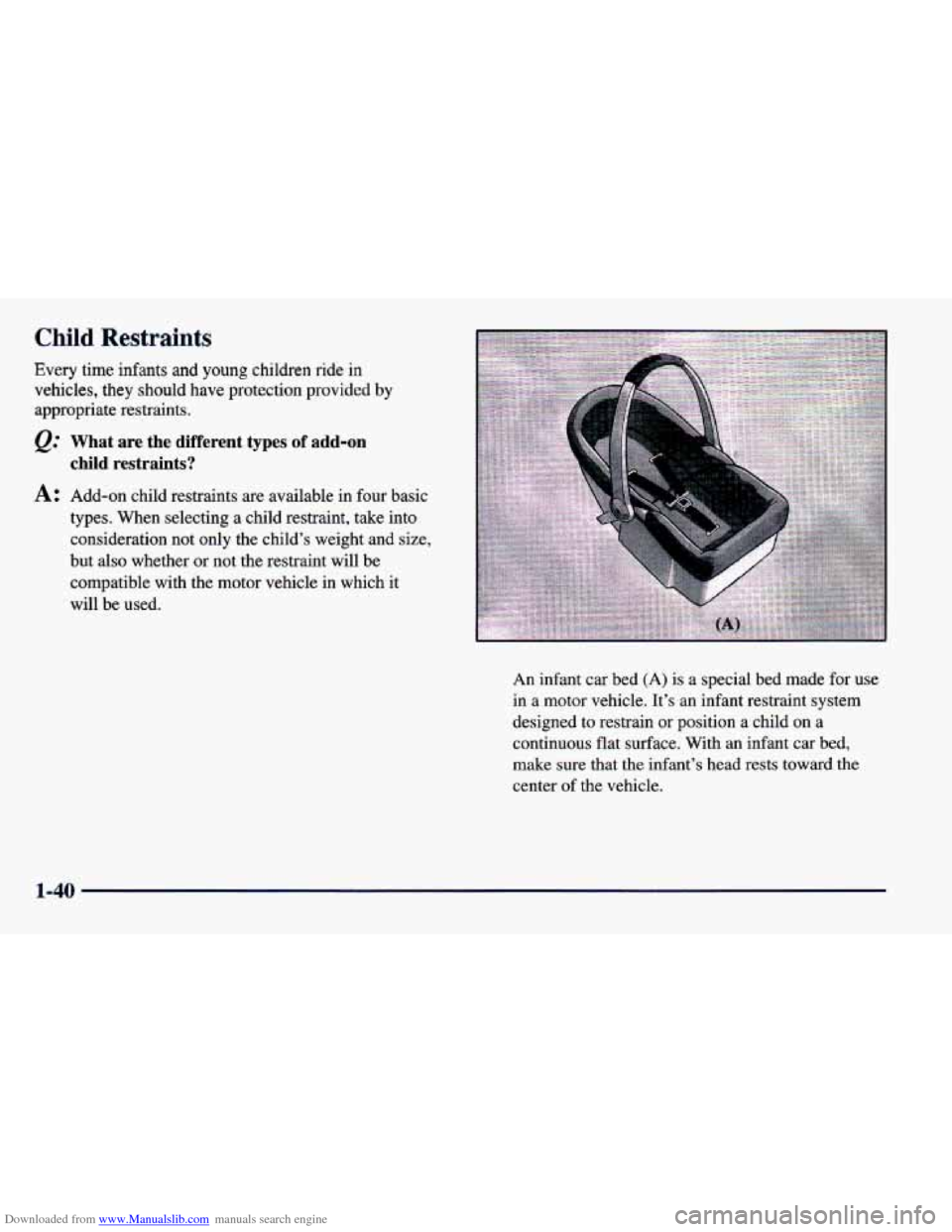
Downloaded from www.Manualslib.com manuals search engine Child Restraints
Every time infants and young children ride in
vehicles, they should have protection provided by
appropriate restraints.
@ What are the different types of add-on
child restraints?
A: Add-on child restraints are available in four basic
types. When selecting a child restraint, take into
consideration not only the child’s weight
and size,
but also whether or not the restraint will be
compatible with the motor vehicle in which it
will be used.
An infant car bed (A) is a special bed made
for use
in a motor vehicle. It’s an infant restraint system
designed to restrain
or position a child on a
continuous flat surface. With an infant car bed,
make sure that
the infant’s head rests toward the
center of the vehicle.
1-40
Page 71 of 400
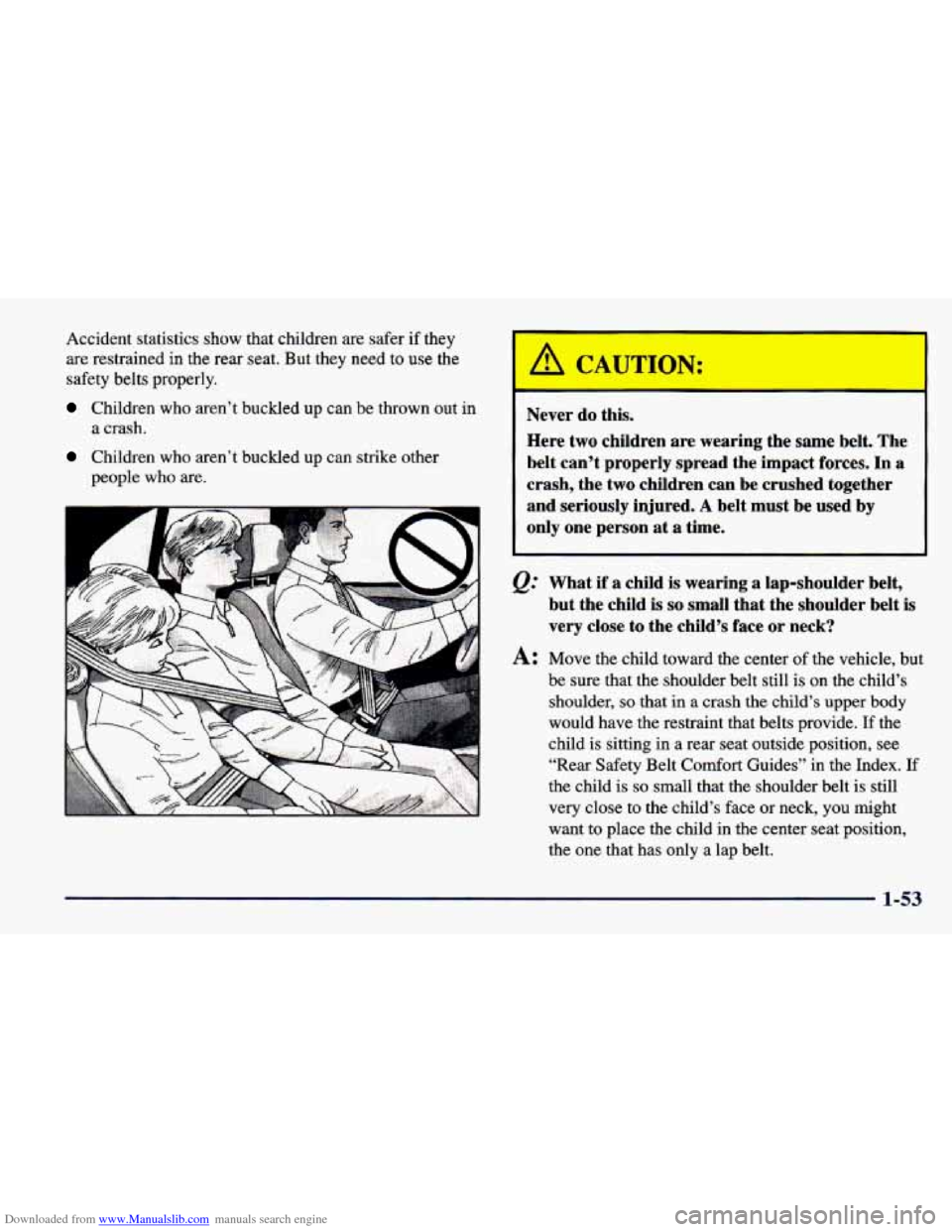
Downloaded from www.Manualslib.com manuals search engine Accident statistics show that children are safer if they
are restrained in the rear seat. But they need to use the
safety belts properly.
Children who aren’t buckled up can be thrown out in
Children who aren’t buckled up can strike other
a crash.
people
who are.
1
. i:
Never do this.
Here two children are wearing the same belt.
The
belt can’t properly spread the impact forces. In a
crash, the two children can be crushed together
and seriously injured.
A belt must be used by
only one person at a time.
&= What if a child is wearing a lap-shoulder belt,
but the child
is so small that the shoulder belt is
very close to the child’s face or neck?
A: Move the child toward the center of the vehicle, but
be sure that the shoulder belt still is on the child’s
shoulder,
so that in a crash the child’s upper body
would have the restraint that belts provide. If the
child is sitting
in a rear seat outside position, see
“Rear Safety Belt
Comfort Guides” in the Index. If
the child is
so small that the shoulder belt is still
very close to the child’s face or neck,
you might
want to place the child in the center seat position,
the one that has only a lap belt.
1-53
Page 89 of 400
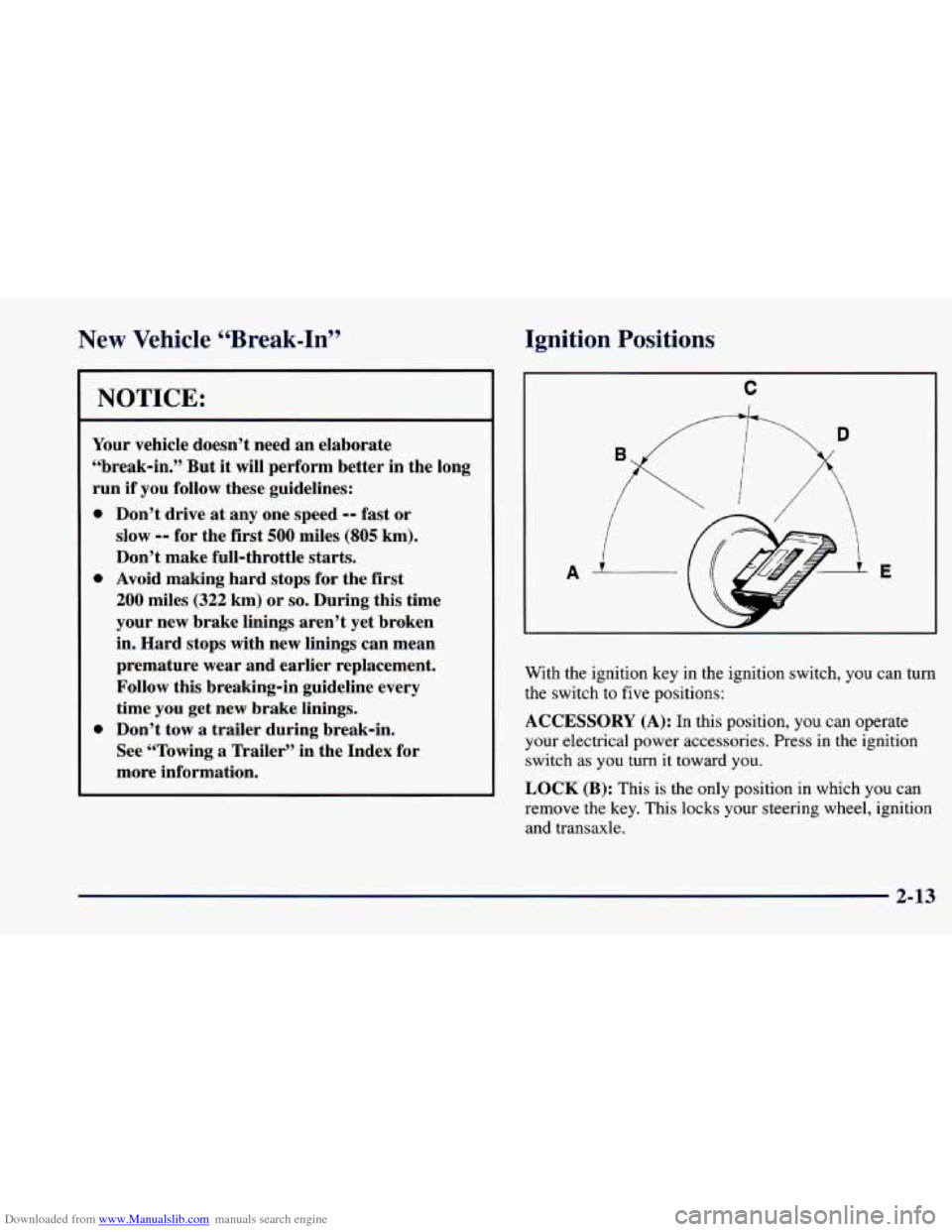
Downloaded from www.Manualslib.com manuals search engine New Vehicle “Break-In” Ignition
Positions
NOTICE:
Your vehicle doesn’t need an elaborate
“break-in.” But
it will perform better in the long
run
if you follow these guidelines:
a
a
0
Don’t drive at any one speed -- fast or
slow
-- for the first 500 miles (805 km).
Don’t make full-throttle starts.
Avoid making hard stops for the first
200 miles (322 km) or so. During this time
your new brake linings aren’t yet broken
in. Hard stops with new linings can mean
premature wear and earlier replacement.
Follow this breaking-in guideline every
time you get new brake linings.
Don’t tow
a trailer during break-in.
See “Towing
a Trailer” in the Index for
more information.
C
A
AL E
With the ignition key in the ignition switch, you can turn
the switch
to five positions:
ACCESSORY (A): In this position, you can operate
your electrical power accessories. Press in the ignition
switch as you turn it toward you.
LOCK (B): This is the only position in which you can
remove the key. This locks your steering wheel, ignition
and transaxle.
2-13
Page 90 of 400
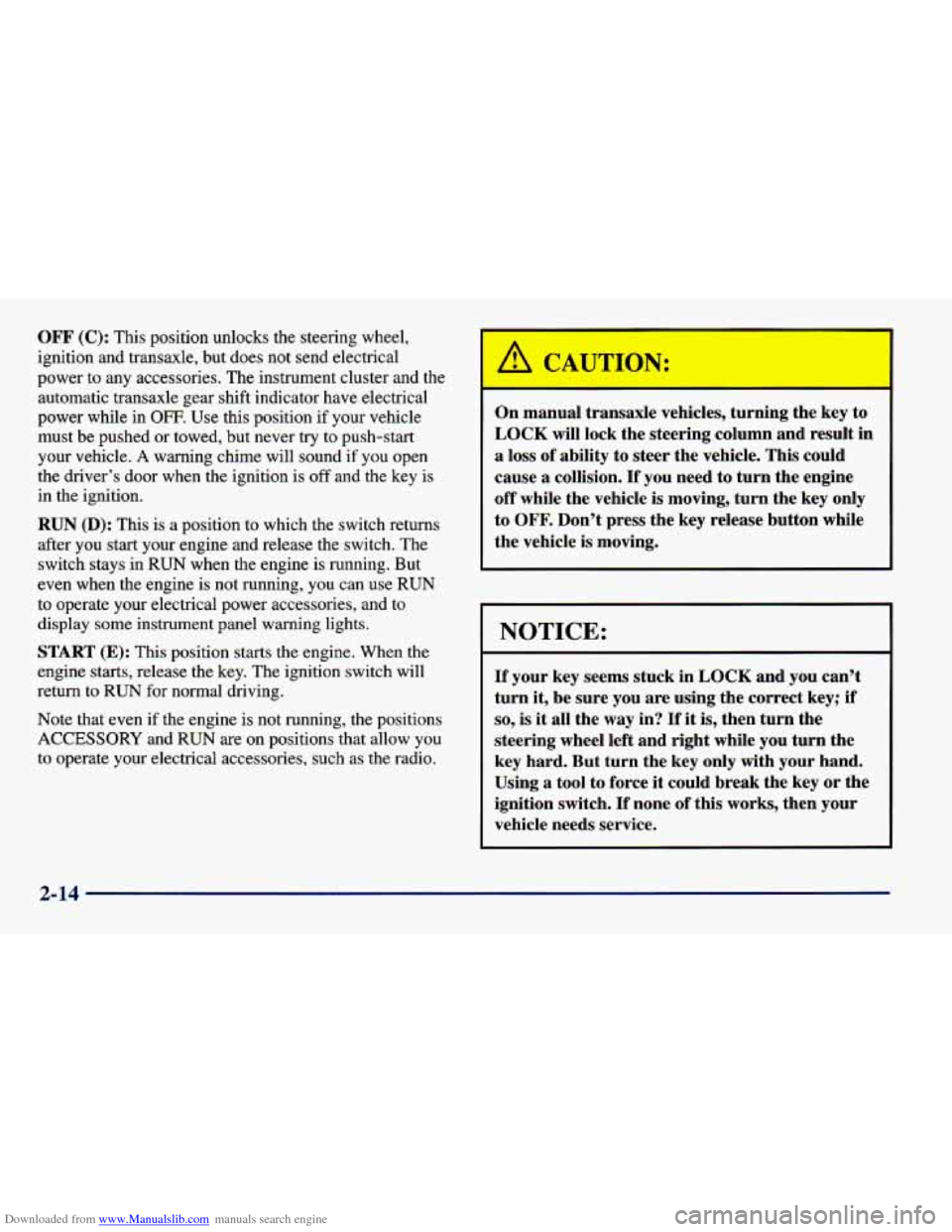
Downloaded from www.Manualslib.com manuals search engine OFF (C): This position unlocks the steering wheel,
ignition and transaxle, but does not send electrical
power to any accessories. The instrument cluster and the
automatic transaxle gear shift indicator have electrical
power while in
OFF. Use this position if your vehicle
must be pushed or towed, but never try to push-start
your vehicle. A warning chime will sound if you open
the driver’s door when the ignition is
off and the key is
in the ignition.
RUN (D): This is a position to which the switch returns
after you start your engine and release the switch. The
switch stays in
RUN when the engine is running. But
even when the engine is not running, you can use
RUN
to operate your electrical power accessories, and to
display some instrument panel warning lights.
START (E): This position starts the engine. When the
engine starts, release the key. The ignition switch will
return to
RUN for normal driving.
Note that even if the engine is not running, the positions
ACCESSORY and RUN are on positions that allow
you
to operate your electrical accessories, such as the radio.
On manual transaxle vehicles, turning the key to
LOCK will lock the steering column and result in
a loss of ability to steer the vehicle. This could
cause a collision.
If you need to turn the engine
off while the vehicle
is moving, turn the key only
to
OFF. Don’t press the key release button while
the vehicle is moving.
I NOTICE:
If your key seems stuck in LOCK and you can’t
turn
it, be sure you are using the correct key; if
so, is it all the way in? If it is, then turn the
steering wheel left and right while you turn the
key hard. But turn the key only
with your hand.
Using a tool to force it could break the key or the
ignition switch.
If none of this works, then your
vehicle needs service.
2-14
Page 92 of 400
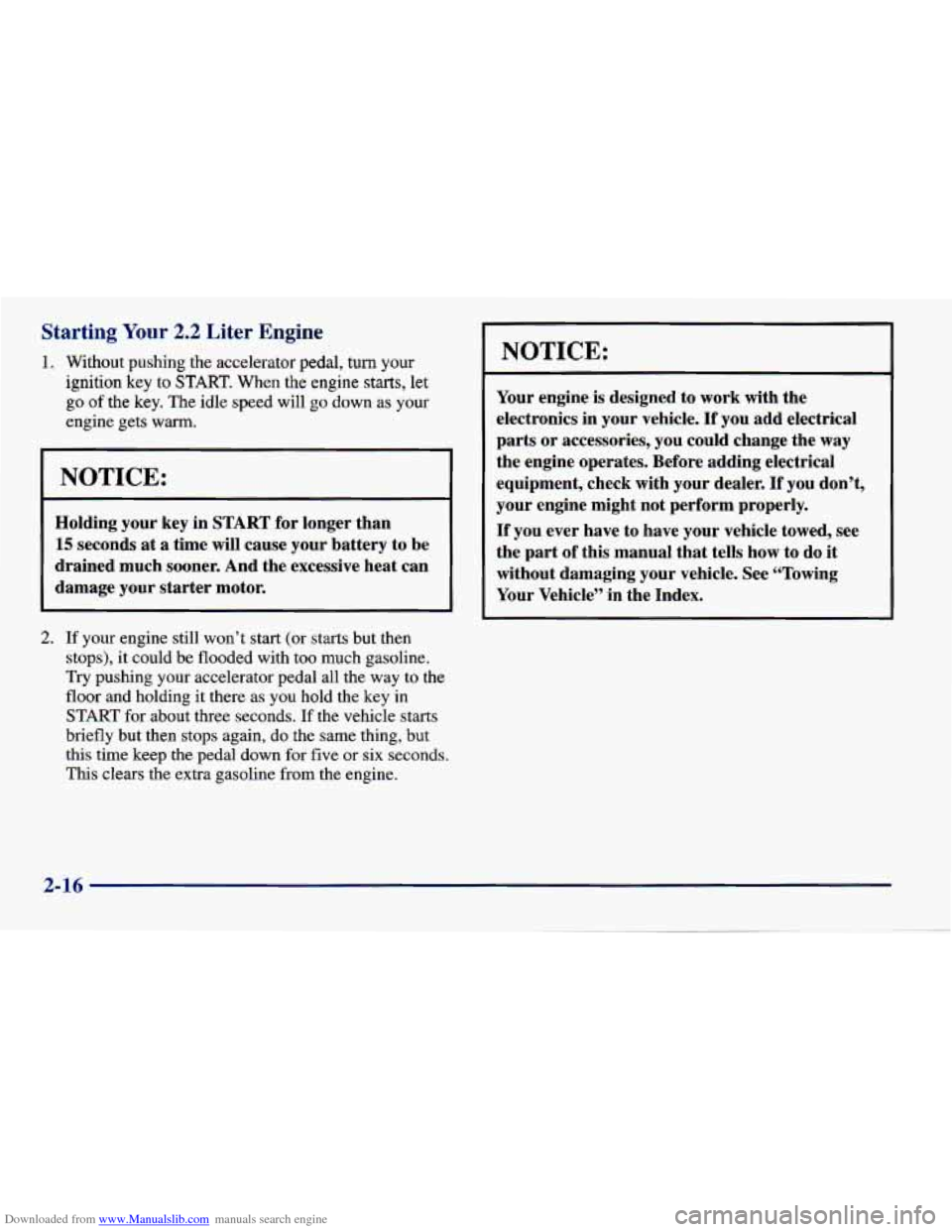
Downloaded from www.Manualslib.com manuals search engine Starting Your 2.2 Liter Engine
1. Without pushing the accelerator pedal, turn your
ignition key to START. When the engine starts, let
go of the key. The idle speed will go down as your
engine gets warm.
r NOTICE:
Holding your key in START for longer than
15 seconds at a time will cause your battery to be
drained much sooner. And the excessive heat can
damage your starter motor.
2. If your engine still won’t start (or starts but then
stops), it could be flooded with too much gasoline.
Try pushing your accelerator pedal all the way to the
floor and holding it there as you hold the key in
START for about three seconds.
If the vehicle starts
briefly but then stops again, do the same thing, but
this time keep
the pedal down for five or six seconds.
This clears the
extra gasoline from the engine.
NOTICE:
Your engine is designed to work with the
electronics in your vehicle. If you add electrical
parts or accessories, you could change the
way
the engine operates. Before adding electrical
equipment, check with your dealer.
If you don’t,
your engine might not perform properly.
If you ever have to have your vehicle towed, see
the part of this manual that tells how
to do it
without damaging your vehicle. See “Towing
Your Vehicle” in the Index.
2-16